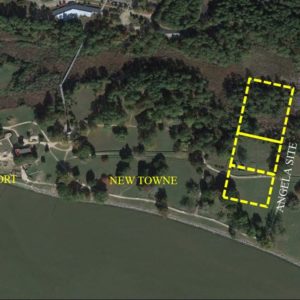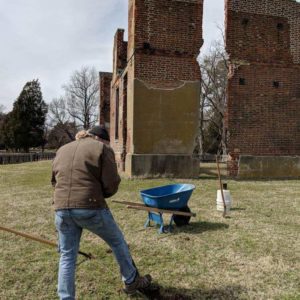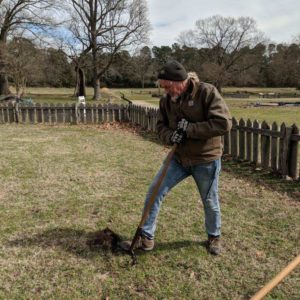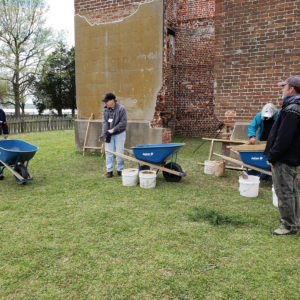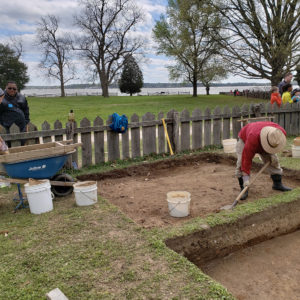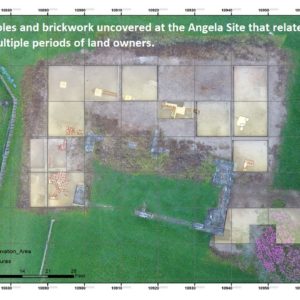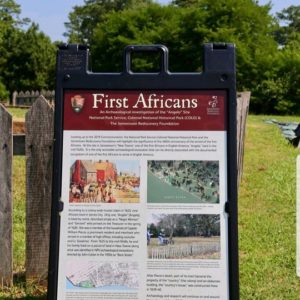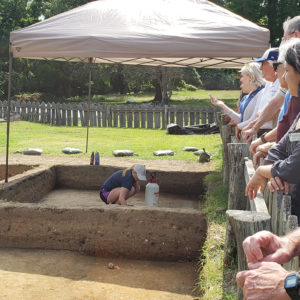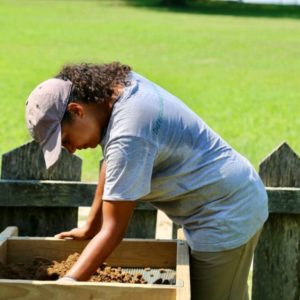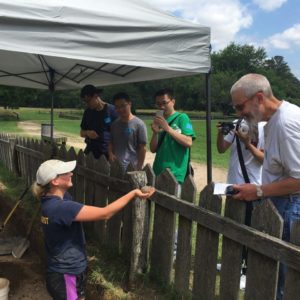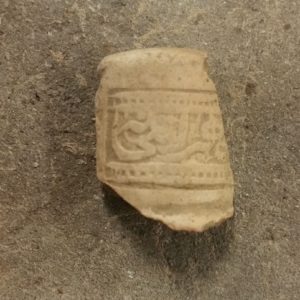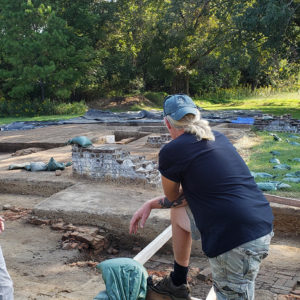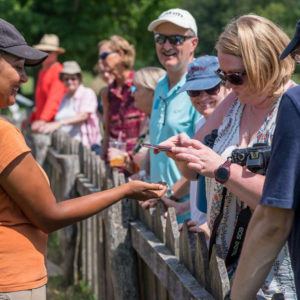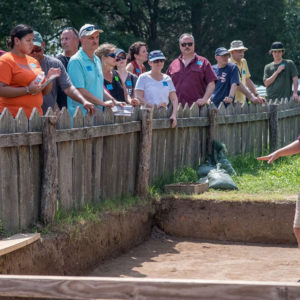Jamestown Rediscovery archaeologists continued to make interesting discoveries at the Angela Site this summer. Thanks to a National Park Service Civil Rights Initiative grant, Rediscovery is working with Colonial National Historical Park (COLO-NPS) in New Town at a site where one of the first documented Africans in English North America lived and worked. Angela, an Angolan woman who arrived in 1619, is listed in the 1625 Muster as living in the household of Captain William Pierce. Archaeologists hope to uncover evidence of Pierce’s house and to find other structures on his property in order to better contextualize Angela’s world.
Last summer, archaeologists focused on an area east of the 18th-century Ambler House, where researchers believe that William Pierce once had a residence, warehouses and a garden. Multiple structures were discovered on the site in the mid-1930s by segregated Civil Conservation Corps (CCC) workers, based at a camp in Williamsburg. National Park Service photographs of this area show that the CCC excavators found a large structure with a brick basement built around the 1690s, likely related to when William Sherwood acquired the property. However, they also found a brick hearth and some postholes that they believed belonged to an earlier building. By re-exposing portions of the structures and surrounding area Rediscovery archaeologists have a better understanding of the maps and drawings left by the CCC and other archaeologists. The new excavations allow for a re-examination of the previous interpretations and reveal what evidence past archaeologists missed.
Rediscovery is especially interested in the brick hearth, orientated slightly off alignment with the later Sherwood structure. Current research has determined that the hearth’s brickwork dates to no later than the 1630s. Director of Archaeology Dave Givens theorizes that this hearth may relate to an addition to Pierce’s house. It is uncertain whether Pierce added the hearth or if it was built by Sir Francis Wyatt, who occupied the site in the mid-1630s after Pierce. Furthermore, they are intrigued by some postholes, mentioned by the CCC, which are sealed by the brick hearth. Pierce’s original house was likely was a post-in-ground structure similar to others built during that time, and the team is hopeful that these postholes could be the footprint for the earliest structure on the site.
“The center of this post-in-ground structure was blown out by the later 1690s building, but there are some pretty big areas that are still intact, and they tell us that the early town where Angela lived is still out here. We just have to dig to find it,” Givens explains.
A number of other wealthy citizens of Jamestown resided on the Pierce lot or had property that overlapped with part of it during the 17th century. Having multiple property owners and building episodes makes sorting the features of the different periods of ownership very challenging. However, by opening more test units, the team is hopeful that more early features related to Pierce’s time will start to reveal themselves.
The newest site opened this summer is located just west of the 2017 site, at the southeast corner of the Ambler House. While this site was not heavy with multiple structures, archaeologists did find a small palisade fence running from the area of the hearth west toward the new site. They also found three outlines for burial shafts that are earlier than any other feature in the area. Their clean fill suggests that they relate to very early occupation of the site and could relate to Pierce’s time. Cutting one of the burials, the team found the outline of a large cellar or well, which likely relates to the 18th century, during the Ambler occupation.
In addition to interns hired for the summer, Rediscovery interpreters and laboratory volunteers joined the archaeological team during the season. They assisted with shoveling and screening overburden from the new units. While the density of artifacts recovered is consistent with excavating in “James Cittie,” a few standout as curiosities. Among the hundreds of tobacco pipe stem and bowl fragments, some native tobacco pipe fragments are perhaps reflective of the site’s use as a trading point among the local Algonquians surrounding Jamestown. Both Pierce and John Rolfe – who lived with the Pierce family at the time – were promoting the use of firearms with local tribal members in an effort to solidify trade networks. Additionally, a first-quarter of the 17th century Ottoman Empire pipe bowl fragment was recovered the first year of the dig. The team learned that John Martin the “Persian” arrived in 1618 and was a close associate of both William Pierce and Sir George Yeardley.
“Whether we’ll find any artifact that was owned or used by Angela is doubtful,” Curator Merry Outlaw says. “But we have found some artifacts that date to Pierce’s time — and they can tell us something about the world in which she lived.”
As excavations continue and word about the site’s importance spreads, visitation at the Angela Site has steadily increased. The Rediscovery education team is promoting a greater awareness of African and African-American experiences at Jamestown with a new First Africans walking tour. Currently presented on Fridays and Saturdays at 2:00 PM, this hour-long tour offers visitors a comprehensive introduction to the first Africans who arrived in 1619, the political climate in their native Angola during this period, and stories of African-Americans who lived at Jamestown throughout the 17th century. The tour stops at several key locations in New Town, and travels the path the first Africans took as they exited ships and walked onto the island. The journey ends at the Angela Site, where on-site archaeologists discuss their latest discoveries.
related images
- Aerial map of New Town and the Angela Site
- Lee McBee opens a new test unit at the Angela Site near the Ambler house
- Lee McBee opens a new test unit at the Angela Site near the Ambler house
- Project Director Dave Givens chats with Jamestown Rediscovery volunteers at the Angela Site
- Jamestown Rediscovery archaeologists and volunteers open new test units at the Angela Site this field season
- Postholes and brickwork uncovered at the Angela Site that relate to the multiple periods of landowners
- Sign at the Angela Site
- Lee McBee updates Jamestown Rediscovery volunteers at the Angela Site
- Chardé Reid screens overburden from test units at the Angela Site
- Katie Dowling shows visitors a cannonball found at the Angela Site
- Fragment of an early 17th-century Ottoman Empire pipe bowl that likely belonged to John Martin, the first Iranian-American in English North America
- Dave Givens and Lee McBee discuss the postholes next to the brick hearth
- Chardé Reid shows visitors some artifacts during one of the First Africans walking tours
- Bruce McRoberts shows visitors on the First Africans walking tour some of the features discovered recently at the Angela Site



